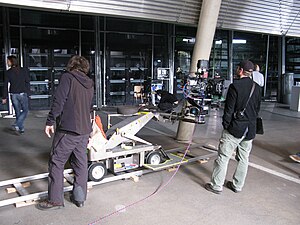
In filmmaking and video production, a crane shot is a shot taken by a camera on a moving crane or jib. Filmmaker D. W. Griffith created the first crane for his 1916 epic film Intolerance, with famed special effects pioneer Eiji Tsuburaya later constructing the first iron camera crane which is still adapted worldwide today. Most cranes accommodate both the camera and an operator, but some can be moved by remote control. Crane shots are often found in what are supposed to be emotional or suspenseful scenes. One example of this technique is the shots taken by remote cranes in the car-chase sequence of the 1985 film To Live and Die in L.A. Some filmmakers place the camera on a boom arm simply to make it easier to move around between ordinary set-ups.
A film crew is a group of people, hired by a production company, for the purpose of producing a film or motion picture. The crew is distinguished from the cast, as the cast are understood to be the actors who appear in front of the camera or provide voices for characters in the film. The crew is also separate from the producers, as the producers are the ones who own a portion of either the film studio or the film's intellectual property rights. A film crew is divided into different departments, each of which specializes in a specific aspect of the production. Film crew positions have evolved over the years, spurred by technological change, but many traditional jobs date from the early 20th century and are common across jurisdictions and filmmaking cultures.
The film industry is built upon many technologies and techniques, drawing upon photography, stagecraft, music, and many other disciplines. Following is an index of specific terminology applicable thereto.

Steadicam is a brand of camera stabilizer mounts for motion picture cameras invented by Garrett Brown and introduced in 1975 by Cinema Products Corporation. The Steadicam brand was acquired by Tiffen in 2000. It was designed to isolate the camera from the camera operator's movement, keeping the camera motion separate and controllable by a skilled operator.

A crane is a machine used to move materials both vertically and horizontally, utilizing a system of a boom, hoist, wire ropes or chains, and sheaves for lifting and relocating heavy objects within the swing of its boom. The device uses one or more simple machines, such as the lever and pulley, to create mechanical advantage to do its work. Cranes are commonly employed in transportation for the loading and unloading of freight, in construction for the movement of materials, and in manufacturing for the assembling of heavy equipment.

A boom operator is a core role in the sound department of a film production, who works with the production sound mixer and utility sound technician. The principal responsibility of the boom operator is microphone placement, usually using a boom pole with a microphone attached to the end, their aim being to hold the microphone as close to the actors or action as possible without allowing the microphone or boom pole to enter the camera's frame.

A camera operator, or depending on the context cameraman or camerawoman, is a professional operator of a film camera or video camera as part of a film crew. The term "cameraman" does not imply that a male is performing the task.
"Below-the-line" is a term derived from the top sheet of a film budget for motion pictures, television programs, industrial films, independent films, student films and documentaries as well as commercials. The "line" in "below-the-line" refers to the separation of production costs between script and story writers, producers, directors, actors, and casting and the rest of the crew, or production team.

A key grip is a senior role for an experienced professional on every movie set. Their responsibilities are extensive and range from supervising grip crews, assessing what equipment is necessary for each shooting location, coordinating the transportation of this equipment and its set up, arranging the general movement and positioning of the camera and collaborating with the director of photography. The key grip relies on the best boy as their foreperson to supervise the grip crew.

In the United States, Canada and the United Kingdom, grips are camera support equipment technicians in the filmmaking and video production industries. They constitute their own department on a film set and are directed by a key grip. Grips have two main functions: The first is to work closely with the camera department to provide camera support, especially if the camera is mounted to a dolly, crane, or in an unusual position, such as the top of a ladder. Some grips may specialize in operating camera dollies or camera cranes. The second function is to work closely with the electrical department to create lighting set-ups necessary for a shot under the direction of the director of photography.
Grips' responsibility is to build and maintain all the equipment that supports cameras. This equipment, which includes tripods, dollies, tracks, jibs, cranes, and static rigs, is constructed of delicate yet heavy duty parts requiring a high level of experience to operate and move. Every scene in a feature film is shot using one or more cameras, each mounted on highly complex, extremely expensive, heavy duty equipment. Grips assemble this equipment according to meticulous specifications and push, pull, mount or hang it from a variety of settings. The equipment can be as basic as a tripod standing on a studio floor, to hazardous operations such as mounting a camera on a 100 ft crane, or hanging it from a helicopter swooping above a mountain range.
Good Grips perform a crucial role in ensuring that the artifice of film is maintained, and that camera moves are as seamless as possible. Grips are usually requested by the DoP or the camera operator. Although the work is physically demanding and the hours are long, the work can be very rewarding. Many Grips work on both commercials and features.

A skidder is any type of heavy vehicle used in a logging operation for pulling cut trees out of a forest in a process called "skidding", in which the logs are transported from the cutting site to a landing. There they are loaded onto trucks, and sent to the mill. One exception is that in the early days of logging, when distances from the timberline to the mill were shorter, the landing stage was omitted altogether, and the "skidder" would have been used as the main road vehicle, in place of the trucks, railroad, or flume. Modern forms of skidders can pull trees with a cable and winch, just like the old steam donkeys, or with a hydraulic grapple either on boom or on the back of the frame (clambunk skidder).

In cinematography, a jib is any boom device used to mount a camera on one end, and a counterweight with camera controls on the other. In principle, it operates like a see-saw, with the balance point located closer to the counterweight, which allows the end of the arm with the camera to move through an extended arc. Typically a jib permits the camera to be moved vertically, horizontally, or a combination of the two. A small jib can be mounted on a tripod, but many larger, purpose-built jibs have their own support stands, often on wheels. Modern jibs are normally modular and can be assembled in various lengths.

A camera dolly is a wheeled cart or similar device used in filmmaking and television production to create smooth horizontal camera movements. The camera is mounted to the dolly and the camera operator and focus puller or camera assistant usually ride on the dolly to push the dolly back and forth. The camera dolly is generally used to produce images which involve moving the camera toward or away from a subject while a take is being recorded, a technique known as a "dolly shot". The dolly grip is the dedicated technician trained to operate the dolly by manually pushing it back and forth.
Television crew positions are derived from those of film crew, but with several differences.
This article contains a list of cinematic techniques that are divided into categories and briefly described.

An engine crane is a common repair tool used in vehicle repair shops to remove or install gasoline or diesel engines in small and crowded vehicle engine compartments. It uses a heavy cantilevered support structure to hold the engine in mid-air so that the mechanic can carefully connect or disconnect fragile hoses and wires on the engine to the frame of the vehicle.
Articles related to the field of motion pictures include:
This glossary of motion picture terms is a list of definitions of terms and concepts related to motion pictures, filmmaking, cinematography, and the film industry in general.

The GBCT is a non-profit organization that serves as a representative body for camera technicians who work in the film and high-end television production industry worldwide. With approximately 450 members, many of whom are also affiliated with other moving image craft organizations such as the British Society of Cinematographers and the Association of Camera Operators, the GBCT operates out of Panavision London offices.

A tie exchanger is a self-propelled railroad maintenance of way vehicle that removes old railroad ties from tracks and inserts new ones. By using mechanical and hydraulic force, a tie extractor/inserter can replace ties much faster and with more precision than is possible by hand.















